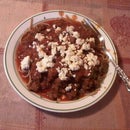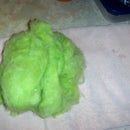Introduction: Card Weaving - How to Make Your Own Cards From Recycled Materials
I'm a spinner and a weaver. I especially love weaving with my own handspun yarns. A dear friend of mine, Sue Woods, traded me a pile of weaving books for my pile of stained glass and supplies a few years ago. I started reading through them all last November when I came across the book, "The Weaving, Spinning, and Dyeing Book" by Rachel Brown. Reading this book led me to buying a book called, "Card Weaving" by Candace Crockett.
I hunted for weaving cards online and quickly learned how to make my own cards for card weaving via this Instructable: https://www.instructables.com/id/Make-Your-Own-Tablet-Weaving-Cards/. I made mine from a recycled deck of pinochle cards because they're much larger than regular plaing cards. The pinochle cards gave me weaving cards that measure 2-1/2" x 2-1/2" and fit my hands quite nicely.
Now, I like the playing card weaving cards well enough, but I've started getting into much more historic weaves and require sturdier weaving cards. This is why a new instructable has been born.
You will need:
Empty and washed cat litter containers with the labels removed (or some 2qt margerine tub lids)
a ruler with a good, straight edge
a good pair of sharp scissors
a Sharpie (this is the only thing that will write on this grade of plastic
a hole punch
Please forgive any line markings you see on the cards. I will try and scrub them off at a later point as they do not interfere with the use of the cards.
Step 1: Locating Recycled Material to Make Your Weaving Cards.
The first step is to find some suitable material capable of standing up to weaving a 3" wide sash, belt, or stole. I recently finished weaving a stole from some leftover acrylic yarn I had laying about and discovered that the playing cards don't really hold up to that amount of weaving without becoming permantly bent and/or folded.
A lot of people recommend cardboard, but I quickly nixed that idea because it doesn't suit my hands nor does it suit the amount of weaving I've been doing. They also don't work so well for double faced card weaving.
I rummaged through the basement last night and found margerine tub lids (the 2qt size) and while they're quite sturdy and will do the trick in a pinch, I wanted something a tad bit stronger and less prone to bending while still being fairly easy to cut with a good pair of scissors.
Enter in the pile of cat litter containers that I hang on to because they're remarkably nice watering containers and make excellent cloches for your tomato seedlings when you put them out.
Once you've located at least 3 good cat litter containers or 12 margerine tub lids, wash them all in hot soapy water, rinse and dry thoroughly.
Step 2: Cut Your Cat Litter Containers Into Sheets
When your cat litter containers are dry, look at one of them closely. You will notice a ridge going around the top edge and along the bottom edge.
Using your sharp pair of scissors, firmly puncture the cat litter container on the short side (so you don't reduce your available card space any further) and cut carefully around the ridge to remove the top. See images!
Step 3: Cut the Panels Out.
You will cut the panels out by following the natural edges of the cat litter container. I have used a ruler and marked them to provide better visuals.
Cut down both the sides first, then cut along the bottom ridge. You have your first sheet. Flip over the container and repeat for the second sheet.
Step 4: Map Out and Mark Your Pieces
Using your ruler and the sharpie, make your marks for 2-1/2", 2-1/4" or 2". If you do the 2-1/2" like I did, you will only get 6 cards per sheet with scraps left over (which you should save because you can use them to make smaller cards or triangle cards). You should get 9 cards per sheet with the 2-1/4" and 2" sizes.
I made a template for 2-1/2" cards first, then I placed each blank sheet over top of it and used my ruler to make neat, straight lines to cut on.
Now, lets talk about kerf: Please keep in mind that a sharpie will add 1/16" of space to your cards so you will want to adjust accordingly or your cards will not all be the same size.
Step 5: Cut Out and Corner Your Cards
Cut along all of your lines. Try to cut down the center of your lines remembering what I mentioned in the previous step about kerf. Set your scraps aside because they can be used later for smaller cards and other things.
Corner your cards by either free cutting a nice curve around each card or you can use a compass like I did when I made the playing card set. For these, I used one of the pinochle cards as a template for my curves.
Cut your corners off. You're almost finished! (Again, please forgive my messy lines. I will scrub them up later.)
Step 6: Punch the Holes in Your Cards
Insert each rounded corner into your hole punch about 1/4" in and punch (yep, you'll have to squeeze the handles pretty good because this plastic is very sturdy). The holes don't need to be exact. All that matters is that they're punched out on the corners and they're far enough in that the corners of the cards won't be too stressed while you're weaving.
I used one of my margerine lid cards as a hole template. It does make it a tad easier. (My humble opinion, of course.)
Step 7: Now You're Ready to Mark Your Cards and Weave.
I mark my cards a little differently because I use software that is 'counter-intuitive' which suits me just fine. It's called Guntram's Card Weaving Thingy and it's a wonderful little app that does it's job of creating drafts remarkably well. It sure does save tons of paper.
I have posted cards labeled for Guntram's software (the pinochle cards) and a card labeled according to all the weaving books (the newly cut out plastic cards). It's your choice.
Yes, I will provide links in my closing step. I will also provide the pictures of the template for using the margerine lids, how I do the triangle cards and for the 2-1/4" and 2" cards.
Step 8: The End - Get Weaving!
Here are the additional things I promised.
http://www.guntram.co.za/tabletweaving/
If you scroll down the page a tad, you'll see the software I'm talking about. This is where I got the Anglo Saxon pattern for the belt I wove and posted on facebook (https://www.facebook.com/media/set/?set=a.589911507686675.1073741828.100000034940540&type=1&l=2b71ee81eb)
A beginners tutorial for card weaving: http://www.shelaghlewins.com/tablet_weaving/TW01/TW01.htm
Other useful card weaving resources: http://www.faerybug.com/SCA/fiber_arts/tablet_weaving.htm
The pictures of the margerine lid templates and the pictures how I do the triangle cutouts with my scraps, complete with hole punching. I just lay the scraps over the top of a pinochle triangle I previously made and mark away! The sides of the finished triangle cards measure 2-1/2".
I have also posted some of my finished work, as well.

Participated in the
Jury Rig It! Contest













